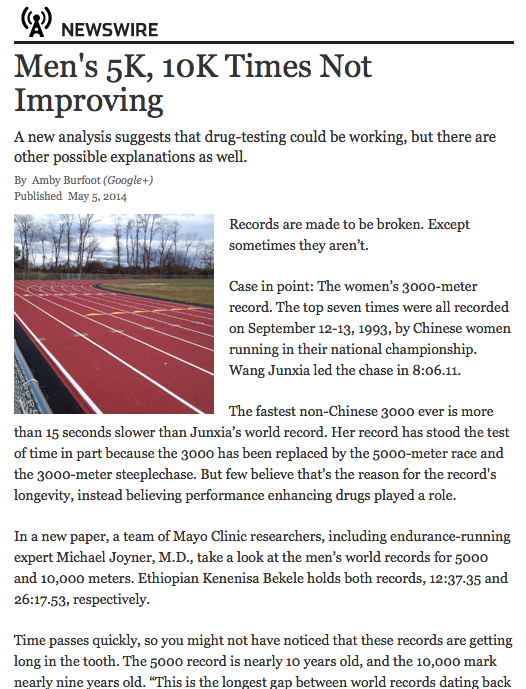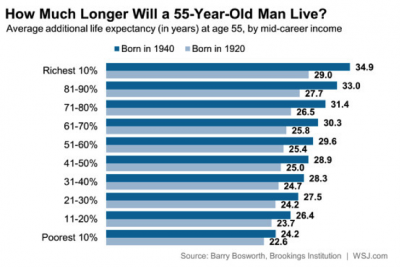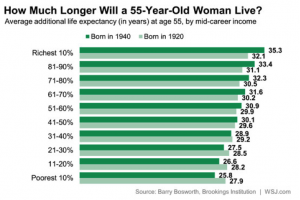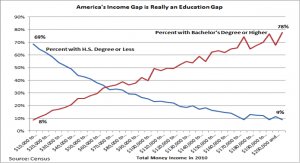Archive for the ‘Current Events’ Category
My Graduation Speech
Last week I had the privilege of giving a commencement address to several hundred graduates from the Department of Integrative Physiology at the University of Colorado, Boulder. I was invited to speak by Dr. Roger Enoka the department chair, who is a world leader in the study of human movement and muscle fatigue, and I was hosted by Dr. Douglas Seals who is world leader in the study of human aging. Roger and Doug have been friends and colleague for more than 30 years. The venue for the address was the beautiful neo-gothic Macky Auditorium on the University of Colorado Campus which dates from the early 1900s. I don’t have a transcript of the talk, but here is what I covered in about 10 minutes on a beautiful spring afternoon in Colorado.
Something Different
Most graduation talks have themes like:
- Our generation has screwed the world up pretty incredibly and we look forward to dumping the mess we made on you guys to solve……
- You think our generation has screwed the world up pretty incredibly but welcome to adulthood so you can see how hard it really is……. We really have been trying.
- How I “made it” by walking 4 miles uphill both directions barefoot in the snow to elementary school……
- Or, the generic be a better humanitarian lecture……
However, I wanted to do something different, so I focused on five lessons and ideas I have picked up over the years. Many of these lessons I saw in action in the person of John T. Shepherd who was my teacher and Sensei when I first came to the Mayo Clinic. The five lessons go something like this:
- Have 1 sharp knife
- Questions & energy are more important than answers
- Master money before it masters you
- Lead from behind
- Learn to ignore
Have 1 Sharp Knife
This lesson is pretty simple and it is about being good at something and engaging your passion. In other words don’t feel compelled to be well rounded. Having a “sharp knife” is especially important as life and work catch up with you and all sorts of potential distractions impinge on your focus. Also, if you can master one thing you will develop a generic set of skills that can be applied as you pursue excellence in other areas.
Questions & Energy Count More Than Answers
Usually school is about mastering information, facts and concepts. However knowledge and ideas and the “right answer” turn over. In medicine for example perhaps 30-40% of what is state of the art care is superseded every 10 years. I am sure this happens in other fields, so if you want to stay at the cutting edge you need to ask good questions and be prepared to have old ideas and dogmas replaced.
Master Money Before it Masters You
We live in a world obsessed with metrics and return on investment thinking. Slogans like “you can’t manage what you can’t measure” abound. However, my guess is that what you can’t measure is what differentiates the outstanding from the good or even success from failure. The other thing we should all remember is that rather than obsessing about what we can afford to do perhaps we should ask if we can afford to not do something. To me embracing calculated risks vs. worrying too much about resources seems like a better way to live.
Lead From Behind
Under most circumstances most of us are not the smartest, wisest, or most experienced people in the room. If you commit yourself to harvesting and facilitating the good ideas of others and delegating authority you will be “more successful” and you will be part of a team that can do way more than any individual can. Some of the best and most innovative people in history like Steve Jobs have essentially stolen, borrowed and/or adapted the ideas of others to great effect. If you can do these things in an inclusive way like John Shepherd could you will be even farther ahead. Additionally, you will be able to lead no matter where you are in an organizational hierarchy via the leverage you generate.
Learn To Ignore
Higher education is about learning to learn, but at least part of life is about learning to ignore. Ignore your own self-doubts. Ignore the ankle biters who are waiting for you and others to fail and be simply average. Also we all need to learn to ignore the difficult side of talented people we might be working with. Frequently talented people are hard driving and passionate. They care, but they can also have ego-centric and difficult sides and resist micro-management. Thus, the question is can you work with these people in a way that their egos are levers and not barriers? This is difficult, it takes patience, and it takes self-control. However, if you can take a calculated risk and help the truly talented get beyond their own egos and chase their dreams there is an upside for everyone. Good coaches understand the value of getting their best players more touches.
Closing Thought
As you look over the five lessons above, I am sure you can see that they are all connected, but a phrase I have heard from my wife (that she heard from her dad) is that “no one cares how much you know until they know how much you care”. When I think of the five lessons it seems to me that one way or another they are all connected by caring.
How Old is Meb?
The celebration surrounding Meb Keflezighi’s unexpected and inspiring victory at the Boston Marathon a few weeks ago is winding down. Beyond the social significance of his victory, his win at almost 39 years of age raises questions about just how old is “old” at the highest levels of athletic competition. I have been interested in this topic for some time, and whenever an athlete in their late 30s or early 40s does something remarkable my medical colleagues and the media start asking just how unique and exceptional performances by such “old” people are. For example in 2008 there was a wave of interest in this topic when the then 41 year old swimmer Dara Torres was preparing for the Olympics (she won a silver in the 50m freestyle). Here are five thoughts that hopefully can put Meb’s win and age in perspective.
First, some data about Meb’s time at Boston where he ran 2:08:37. This is important because there was a nutty piece in the Wall Street Journal suggesting that a sandbagging conspiracy by the other runners let him win with a slow time. In 1975 Bill Rogers was the first man to run the Boston in less than 2:10. Starting in 75 the winning time has been greater than 2:10 a total of 14 times, between 2:09 and 2:10 twelve times, between 2:08 and 2:09 six times, and faster than 2:08 only 6 times. If you look at the winning times at Boston since 1975, with the exception of a couple of outlier years in 2010 and 2011, they have been remarkably stable and Meb’s time would have won 14 of the last 20 races. Over this time Kenyans and Ethiopians won 18 of 20 races. In 2011 there was also a major tailwind that clearly explains the times in the 2:03s that year. If the over/under betting line at Boston is 2:08 next year, I will bet over.
The second issue is why did the pack let Meb get away and open up a lead via high risk front running? My guess is that many of the top runners did not realize just how fast 2:08 is at Boston, and they figured they could run Meb down later. This is problematic because the first two-thirds of the course is downhill and going downhill for that long that fast takes the snap right out of even the fastest runners legs. There is also precedent for front running in major marathons. Frank Shorter used similar tactics when he won the gold medal at Munich in 1972, and the story of that race is told beautifully by Kenny Moore (the 4th place finisher) in a piece he wrote for Sports Illustrated. My bet is that when he took off and no one chased a sort of groupthink set into the lead pack while they waited for him to fade a few miles down the road.
Third, Meb is not the first fast old guy. The great Ethiopian Mamo Wolde was 36 or 37 when he won gold in 1968 and 40 or 41 when he won the bronze at Munich in 1972. Carlos Lopes won the 1984 Olympic marathon at age 37 and a year later was the first man under 2:08. In the 1970s Jack Foster did well in Olympics in his early 40s and won the Honolulu Marathon at 43. At age 41 he went 2:11 and won a silver medal at the Commonwealth games. The women’s marathon in Bejing was won by 38 year old Constantina Diţă of Romania. The current masters world record is held by Andres Espinosa of Mexico who ran 2:08:46 at age 40 in 2003. All of these performances are remarkable and a 2:08 marathon is the equivalent of a 100m time of about 10 seconds flat or a mile of about 3:51.
Fourth, how is this possible? It turns out the major determinants of distance running performance including maximal oxygen consumption can be remarkably well preserved up to about age 40 and beyond, provided there is an adequate training stimulus including a lot of fast running. Motivation is also a key and the emergence of prize money and sponsorship over the last 20 or 30 years (Meb won $100,000 at Boston) has likely encouraged people to keep training and competing for longer. Improvements in sports medicine also make it easier for people to recover from injuries that were once career ending.
Fifth, don’t forget aging in other sports? When you get beyond distance running all sorts of other examples emerge like Julius Boros winning the PGA golf championship when he was 48, Ted Williams hitting 388 at age 38, and Warren Spahn winning 23 games in the major leagues when he was 42. Randy Johnson pitched a perfect game at age 40. There is also a long list of ice hockey players who have done well in their 40s, and don’t forget about boxers like Archie Moore and Bernard Hopkins who won championships in their late 40s. You can argue that the golf and baseball examples don’t count as much because these sports are more about skill and experience than conditioning, but you have to be in shape to play hockey and box. Incredibly, Chris Horner won the Vuelta a España cycling race at age 42 in 2013. If space were unlimited I could go on and on with examples.
Where will it all end? My guess is that we are going to see the number of people in their late 30s and early 40s who do well at the highest level of sport continue to grow, and it is just a matter of time until someone over 40 wins a major marathon or joins Mamo Wolde with an Olympic medal. It is also just a matter of time until someone over 50 wins a major golf championship (Tom Watson got 2nd at the British Open at age 59 in 2009) or perhaps pitches in and wins a World Series game. As the original ageless athlete Satchel Paige asked, “How old would you be if you didn’t know how old you are?” For Meb Keflezighi, and many others, the answer is we just don’t know.
The Life Expectancy Gap & Income
I have done a number of posts on the influence of income and eduction on life expectancy. This topic will get more and traction as discussion about raising the retirement age accelerates due to the demographic pressure on programs like Social Security and Medicare. If the retirement age is raised, the argument is that it will unfairly penalize people with lower incomes.
New Data on Income vs Life Expectancy
The graphics below are some new estimates by the Brookings Institution published in the Wall Street Journal that show the effects of income on life expectancy. The data show that better off people live longer and that this wealth effect is increasing for people born in 1940 vs. 1920. Life expectancy is actually getting worse for poor white women!
Education & Income
The graph below from the Tax Foundation shows that for the purposes of the sorts of population based comparisons I am making in this post, that education and income are essentially the same thing. This will become important as I try to factor out just how much of the life expectancy income/education gap is about money or perhaps other factors. If you use this graph and extrapolate the income and education data people without high school educations live 10 or more years less than those with bachelor’s degrees or higher. That is about what the life expectancy difference looks like when the top and bottom 10 or 20% of incomes are compared.
What About Sweden?
Sweden is a country that has done all it can to reduce and modulate the effects of social and economic inequality on its population. So are there life expectancy differences by income or education in Sweden? The graph below shows the data for a number of countries in Europe including Sweden. The individuals in top 25% of educational attainment (essentially college or more) are being compared to the individuals who did not finish high school. In Sweden the most educated men live about 4 years longer and the Women live about 3 years longer than their least educated counterparts. If you compare this to the differences between the top and bottom 10-20% of incomes in the US the differences are about 7 years for men and 8 for women. This number for men in the US is similar to the average value for OECD 14 countries but the gap for women in the U.S. is much higher.
The Persistent Gap
The point of all of this is that there is an income/education/life expectancy gap and even the social democracies of Northern Europe can’t make it go away. What is interesting is that like the US, smoking and other negative health behaviors are generally lower in well off and better educated people in this part of the world.
“The prevalence of smoking was higher in Denmark compared to Sweden. The total attributable fraction (TAF) of low education regarding daily smoking was 36% for Danish men and 35% for Danish women, and 32% and 46%, respectively, for Swedish men and women. TAF of low education regarding continued smoking were 16.2% and 15.8% for Danish men and women, and 11.0% and 18.8% for Swedish men and women, respectively”
The statistics in the paper above are a bit obscure but in the U.S. smoking and inactivity rates are typically higher by 2-4 times or more in the least vs. most educated and well off people.
Take Home Messages & Thoughts
- When I try to integrate the data above for men it seems to me that perhaps 30-40% of the life expectancy gap in the U.S. is due to general economic insecurity and things like lack of health care. However, a gap persists in countries where these concerns are not nearly as dramatic as they are in the U.S. However, like the U.S., there are education and income related differences for things like smoking just about everywhere.
- For women, it is worse in the U.S. and appears to be headed in the wrong direction. My guess is that women, especially poor women, are now participating in unhealthy behaviors as social taboos against smoking for example have faded.
- I remain an advocate of sin taxes.
- Education leads to income and to get educated you have to have infrastructure at home when and you have to develop some impulse control and ability to “self-regulate” early in life. I am not sure how to make this work from a policy perspective, but it is pretty clear that intensive early childhood interventions for poor kids can make a huge difference in terms of educational achievement, income and later health.
“High-quality early childhood programs have been shown to have substantial benefits in reducing crime, raising earnings, and promoting education. Much less is known about their benefits for adult health. We report on the long-term health effects of one of the oldest and most heavily cited early childhood interventions with long-term follow-up evaluated by the method of randomization: the Carolina Abecedarian Project (ABC). Using recently collected biomedical data, we find that disadvantaged children randomly assigned to treatment have significantly lower prevalence of risk factors for cardiovascular and metabolic diseases in their mid-30s. The evidence is especially strong for males. The mean systolic blood pressure among the control males is 143 millimeters of mercury (mm Hg), whereas it is only 126 mm Hg among the treated. One in four males in the control group is affected by metabolic syndrome, whereas none in the treatment group are affected. To reach these conclusions, we address several statistical challenges. We use exact permutation tests to account for small sample sizes and conduct a parallel bootstrap confidence interval analysis to confirm the permutation analysis. We adjust inference to account for the multiple hypotheses tested and for nonrandom attrition. Our evidence shows the potential of early life interventions for preventing disease and promoting health.”
- I generally have a libertarian perspective on things like legalizing and taxing marijuana, however I am not sure if this will help solve the problem of people getting left behind in the education, income and ultimately health race.
- Finally, when people tell you that raising the retirement age is unfair to people who make less money, tell them to channel Jack Kemp, because what the poor need is a way out of poverty.
Redefining Human Limits: Bernard Hopkins, Ashton Eaton, Michael Phelps, and Steve Way
There have been some remarkable performances recently showing just how well 40 somethings can do in elite athletic competition. Then there seem to be more and more startling performances in general. There is also the issue of Michael Phelps coming back for his fifth Olympics and trying to add more medals to his total. Finally, unknowns still come out of nowhere. All of this seems to be redefining the limits of what is possible.
Bernard Hopkins
Last weekend 49 year old Bernard Hopkins unified the light-heavyweight (175 lbs, 78Kg) boxing title and now holds all of the titles in the alphabet soup of boxing. Boxing is a crazy and some would say barbaric sport, but to fight 12 rounds you have to be in superb condition and the speed, coordination, timing, and footwork of great boxers are all outstanding. I keep a list of great performances by older athletes and there have been some dominant performances by people in their late 30s and early 40s, and a number of people have done well at the highest level of their sport into their late 40s. However, what Hopkins has done is incredible and I can’t think of anything that comes close.
Ashton Eaton
Speaking of anything that comes close, Olympic Decathlon champ and world record holder Ashton Eaton entered the 400m hurdles at the Mt. Sac Relays last weekend. He ran 50.01 and got fourth. This is a time that is at the edge of world class in arguably the toughest race in track and field. Incredibly, Eaton essentially ran the race without ever really practicing it. He is a superb high hurdler (13.35) and also excellent at the 400m (45.64), but to go out and blast a 50.01 is nuts. Milt Campbell was a world record holder in the high hurdles, a gold medalist in the decathlon (1956, he got a silver in 52), state champ swimmer, and professional football player. However, if Eaton becomes world class at the 400m hurdles, that will be truly out of this world.
Michael Phelps
Ashton Eaton may be “dabbling” in the 400m hurdles because he is “bored”, the other bored person appears to be Michael Phelps. Phelps is coming back in an effort to add to 20 plus medals. There was an analysis of “older swimmers” (Phelps will be 31 at the next Olympics) on the 538.com website. The analysis pointed out that it is unusual for swimmers to do well past their mid-20s, and that rest of the field is catching up to times that Phelps posted during his peak. All of this is true and would suggest that it will be hard for Phelps to medal again.
However, the era of large numbers of swimmers continuing into their late 20s and early 30s may just be starting. Swimming was relatively late to fully professionalize and it is only recently that the financial incentives have been there to keep many people going past 25 or 26. The other issue is that swimmers start to train very hard in their early teens and most are tired of the grind after 10 plus years. Phelps seems to be settling into a pattern of 18 easy months post Olympics followed by a build up for the next Olympics. He also does not have to swim 6 or 8 races in 2016 and could easily focus on a couple of events. So, don’t count him out.
Steve Way & Talent Identification
Steve Way was an overweight (224lb, 101kg) smoker who started running in 2007. A couple of weeks ago he ran 2:16 at the London Marathon and he is also a leading ultra-marathoner in Europe. Way is 39 years old. I have done a number of posts on talent identification, and the wasted talent that is out there in many countries. If all of the Steve Ways of the world were found and could be motivated to train as youngsters, would the East Africans be so dominant?
Closing Thoughts
The examples above all highlight things I have posted on in the last couple of years. However, the examples of Hopkins and Way are perhaps the most extreme examples related to aging and talent identification I have ever seen. Eaton and Phelps are just plain other worldly and perhaps their efforts show what a bit of boredom can do in the right hands.
Denial: Paying College Athletes & Paying for the Interstate Highways
I have been traveling extensively the last few weeks and have not had the time to do a post. During that time two things in the headlines have hit me that exemplify larger issues that seem to underlie so much of what troubles the world today. The first issue is the pervasive combination of double-standards, money, and media that is seen in major college sports in the U.S. The second issue is that the Federal Highway Trust Fund is almost out of money while our roads and bridges continue to decay. I see these two seemingly different issues as linked by a pervasive culture of denial by people who should know better.
College Sports
This issue has come to a head recently with the so-called Ed O’Bannon lawsuit and also the recent ruling that football players at Northwestern University are in fact employees and can unionize. The O’Bannon case is about the NCAA, the governing body that oversees most college sports in the U.S., profiting from the use of player images in video games while the athletes are essentially forbidden from profiting from the same images. There are all sorts of other restrictions about what athletes can and mostly can’t do that can be summarized as the NCAA holding the so-called student athletes to 19th century standards of amateurism. The rub comes mostly in men’s football and basketball which generate literally billions of dollars of economic activity per year and financial bonanzas for coaches.
You can slice the issues related to college sports many ways:
- What happens in non-revenue sports and at the schools with less emphasis on sports is different than what happens in so-called revenue sports which are mostly Division 1 men’s football and basketball. The vast majority of athletes participating in college sports compete in obscurity and enjoy the competition and personal development that comes from playing at a high but anonymous level. So, a whole lot about college sports does not need to be fixed.
- Why should institutions of higher learning be de facto developmental leagues for professional football and basketball?
- If coaches can jump from school to school, why can’t players?
- If education is the primary purpose of a scholarship for a “student-athlete”, why are they given on a year to year basis instead of for four years? Why do practice time and other activities look and feel like a full time job?
- If schools can sign marketing deals with shoe companies, why can’t the players endorse products?
- If the players in the big money men’s sports are paid, what does that mean for gender equality, and how are all out bidding wars for high school talent prevented? The professional leagues have mechanisms in place to keep the talent acquistion field level. Do we want a salary cap for college football?
Questions and observations like these are endless and there are many defenders of the current system that seem mostly united by their economic interest in the status quo. I just hope that whatever emerges next in big time college sports reflect the economic and media realities that are out there. The players are not stupid and it is impossible to believe that University Presidents don’t understand the questions and see the double standards I have outlined above. Is it too much to ask for an end to the denial and a little honesty and transparency from them?
The Interstates
The U.S. Interstate Highway System is one of the greatest (if not the greatest) civil engineering, economic development, and infrastructure projects in the history of humanity. It is also a great example of how the States and Federal government can cooperate to do visionary things. Many elements of the system were built in the 50s and 60s and need major repairs and upgrades.
The Interstates are funded by a trust fund that relies on revenue from gas taxes and it is projected to run out of money next year. The gas tax has not been raised since the early 1990s, and in general tolls are not allowed as a primary means to fund the Interstate system. Also, as people move to hybrid and alternative fuel vehicles and gas mileage rises in traditional cars, perhaps something more than a simple pay at the pump gas tax is needed. From what I can tell no one denies that the trust fund is almost out of money and no one denies that something needs to happen such as either increasing the gas tax or permitting widespread use of tolls. The issue here seems to be about denying that political compromise and deal making is actually a good thing. The inability of our elected officials to address, in a timely fashion, a problem that has minimal liberal/conservative ideological baggage is not a good sign. I hesitate to imagine what will happen when the trust funds supporting more politically charged programs like Medicare and Social Security run out of money in the 2020s and 2030s.
No Hiding?
The boxing champion Joe Louis said of his smaller and faster rival Billy Conn that “he can run but he can’t hide.” It seems to me that when it comes to fixing the double standards in big money, big media college sports and fixing the Interstates those responsible can “deny but they can’t hide.”
You are currently browsing the archives for the Current Events category.








